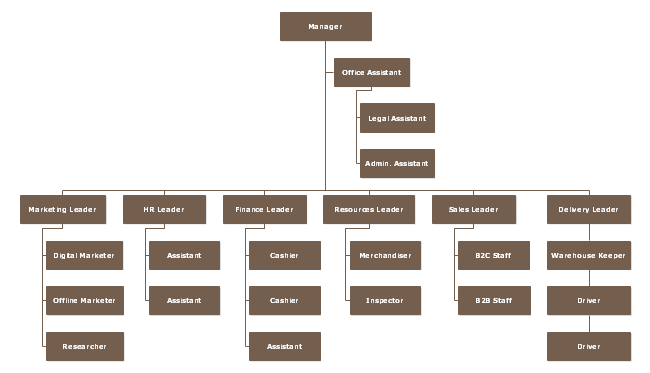
#Small company org chart free#
Authority is flexible, and the autonomous environment promotes a free flow of information. On the other end of the spectrum is an org chart that is defined through organic positioning. If your company involves a market that shifts arbitrarily, an organic org chart may work better. In this model, teams only collaborate as needed. It may be hard for a company to keep up with a swiftly changing market if their organization is structured too tight.

The hierarchical structure can be organized based on a variety of positions in a company involving:Ī bureaucratic org chart is very formal and highly centralized. There will always be someone seated at the highest possible spot. Specific standards and practices are used to govern every aspect of decision-making.Ī mechanistic organization chart is based on top-down management. One or two entities ultimately make final decisions.

This type of organization (also called a bureaucratic or mechanical structure) is known for having a narrow span of control that follows more traditional patterns of organization.īelow is an example of what this organizational chart might look like: If you want to create a more autonomous environment, one that is more linear, then your org chart will look very different from that of a company focused on who manages whom and who’s in charge of what department. It’s also crucial that you have a sense of what kind of company you want to be. There are several different types of org charts that fall on the spectrum, and it’s important to understand the flow of each before deciding which is better for you. Each method has sociological advantages and disadvantages. Types of Org ChartsĬompanies can either be flexible and organic, or structured in a more mechanical and departmentalized manner. Not only that, but it also provides your team with a clear outline of who supports whom. It guides everyone on accountability and creates the foundation for corporate growth. It establishes how proposals, requests, and issues are communicated and the line of authority to manage them.Īn org chart will arrange the decision-making process and answer the how, who, and where of daily operations. These types of systems determine which tasks are delegated and where work is approved. An org chart lays the groundwork for the way a business functions and how roles are maintained. What is an Organization Chart?Ĭonsider this the roadmap of your company culture. Therefore, a company looking to grow must develop a configured system early on.Įnter: The Organization Chart. The truth is, the more products and people added to the equation, the harder it is to keep everything together. It may surprise you to learn that organization is a crucial factor in determining whether or not your business will be able to collaborate effectively. While all those areas may contribute in some way, they aren’t solely responsible for achieving effective collaboration. It doesn’t depend on what your company does or what it’s selling. The key to effective business collaboration isn’t contingent on the type of personality that your team exhibits.


 0 kommentar(er)
0 kommentar(er)
